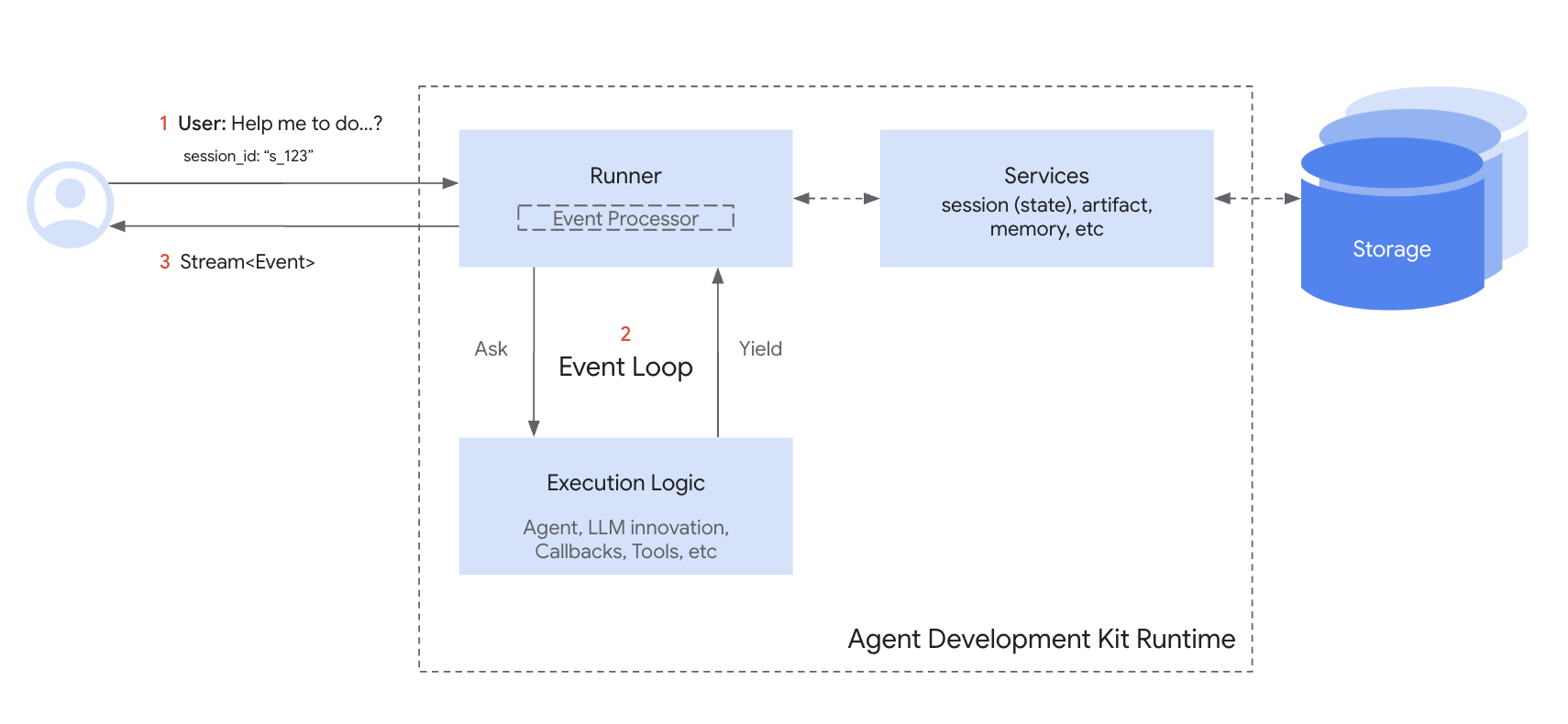Session:跟踪个别对话¶
Supported in ADKPython v0.1.0Go v0.1.0Java v0.1.0
在前述介绍之后,让我们深入了解 Session。回想一下"对话线程"的概念。就像你不会每次发短信都从头开始一样,智能体也需要了解当前交互的上下文。Session 是 ADK 专门设计用于跟踪和管理这些单独对话线程的对象。
Session 对象¶
当用户开始与你的智能体交互时,SessionService 会创建一个 Session 对象(google.adk.sessions.Session)。该对象作为单个对话线程相关所有内容的容器。其主要属性如下:
- 标识 (
id,appName,userId): 对话的唯一标签。id: 此特定对话线程的唯一标识符,对于以后检索至关重要。一个 SessionService 对象可以处理多个Session。此字段标识我们引用的是哪个特定的会话对象。例如,“test_id_modification”。app_name: 标识此对话属于哪个智能体应用程序。例如,“id_modifier_workflow”。userId: 将对话链接到特定用户。
- 历史 (
events): 在此特定线程中发生的所有交互(Event对象——用户消息、智能体响应、工具操作)的时间顺序序列。 - 会话状态 (
state): 一个仅存储与此特定、正在进行的对话相关的临时数据的地方。这在交互期间充当智能体的草稿板。我们将在下一节中详细介绍如何使用和管理state。 - 活动跟踪 (
lastUpdateTime): 一个时间戳,指示此对话线程中最后一次发生事件的时间。
示例:检查 Session 属性¶
from google.adk.sessions import InMemorySessionService, Session
# Create a simple session to examine its properties
temp_service = InMemorySessionService()
example_session = await temp_service.create_session(
app_name="my_app",
user_id="example_user",
state={"initial_key": "initial_value"} # 可以初始化 state
)
print(f"--- 检查 Session 属性 ---")
print(f"ID (`id`): {example_session.id}")
print(f"应用名 (`app_name`): {example_session.app_name}")
print(f"用户 ID (`user_id`): {example_session.user_id}")
print(f"状态 (`state`): {example_session.state}") # 这里只显示初始状态
print(f"事件 (`events`): {example_session.events}") # 初始为空
print(f"最后更新时间 (`last_update_time`): {example_session.last_update_time:.2f}")
print(f"---------------------------------")
# 清理(本例可选)
temp_service = await temp_service.delete_session(app_name=example_session.app_name,
user_id=example_session.user_id, session_id=example_session.id)
print("temp_service 的最终状态 - ", temp_service)
appName := "my_go_app"
userID := "example_go_user"
initialState := map[string]any{"initial_key": "initial_value"}
// Create a session to examine its properties.
createResp, err := inMemoryService.Create(ctx, &session.CreateRequest{
AppName: appName,
UserID: userID,
State: initialState,
})
if err != nil {
log.Fatalf("Failed to create session: %v", err)
}
exampleSession := createResp.Session
fmt.Println("\n--- Examining Session Properties ---")
fmt.Printf("ID (`ID()`): %s\n", exampleSession.ID())
fmt.Printf("Application Name (`AppName()`): %s\n", exampleSession.AppName())
// To access state, you call Get().
val, _ := exampleSession.State().Get("initial_key")
fmt.Printf("State (`State().Get()`): initial_key = %v\n", val)
// Events are initially empty.
fmt.Printf("Events (`Events().Len()`): %d\n", exampleSession.Events().Len())
fmt.Printf("Last Update (`LastUpdateTime()`): %s\n", exampleSession.LastUpdateTime().Format("2006-01-02 15:04:05"))
fmt.Println("---------------------------------")
// Clean up the session.
err = inMemoryService.Delete(ctx, &session.DeleteRequest{
AppName: exampleSession.AppName(),
UserID: exampleSession.UserID(),
SessionID: exampleSession.ID(),
})
if err != nil {
log.Fatalf("Failed to delete session: %v", err)
}
fmt.Println("Session deleted successfully.")
import com.google.adk.sessions.InMemorySessionService;
import com.google.adk.sessions.Session;
import java.util.concurrent.ConcurrentMap;
import java.util.concurrent.ConcurrentHashMap;
String sessionId = "123";
String appName = "example-app"; // 示例 app 名称
String userId = "example-user"; // 示例用户 id
ConcurrentMap<String, Object> initialState = new ConcurrentHashMap<>(Map.of("newKey", "newValue"));
InMemorySessionService exampleSessionService = new InMemorySessionService();
// Create Session
Session exampleSession = exampleSessionService.createSession(
appName, userId, initialState, Optional.of(sessionId)).blockingGet();
System.out.println("Session created successfully.");
System.out.println("--- Examining Session Properties ---");
System.out.printf("ID (`id`): %s%n", exampleSession.id());
System.out.printf("应用名 (`appName`): %s%n", exampleSession.appName());
System.out.printf("用户 ID (`userId`): %s%n", exampleSession.userId());
System.out.printf("状态 (`state`): %s%n", exampleSession.state());
System.out.println("------------------------------------");
// Clean up (optional for this example)
var unused = exampleSessionService.deleteSession(appName, userId, sessionId);
(Note: The state shown above is only the initial state. State updates happen via events, as discussed in the State section.)
使用 SessionService 管理会话¶
如上所示,你通常不会直接创建或管理 Session 对象,而是通过 SessionService。该服务作为会话生命周期的中央管理者。
其核心职责包括:
- 开启新对话: 当用户开始交互时,创建新的
Session对象。 - 恢复已有对话:: 通过 ID 检索特定
Session,让智能体可以从上次中断处继续。 - 保存进度: 将新的交互(
Event对象)追加到 session 历史。这也是 sessionstate更新的机制(详见State章节)。 - 列出对话: 查找特定用户和应用的活跃会话线程。
- 清理: 当对话结束或不再需要时,删除
Session及其相关数据。
SessionService 实现¶
ADK 提供了多种 SessionService 实现,你可以选择最适合需求的存储后端:
-
InMemorySessionService{: #inmemorysessionservice }- 工作方式: 直接将所有 session 数据存储在应用内存中。
- 持久性: 无。应用重启后所有对话数据都会丢失。
- 依赖: 无需额外配置。
- 适用场景: 快速开发、本地测试、示例,以及不需要长期持久化的场景。
-
VertexAiSessionService- 工作方式: 通过 API 调用使用 Google Cloud Vertex AI 基础设施进行会话管理。
- 持久性: 是。数据通过 Vertex AI Agent Engine 可靠且可扩展地管理。
- 要求:
- 最佳用途: 部署在 Google Cloud 上的可扩展生产应用,特别是与其它 Vertex AI 功能集成时。
# Requires: pip install google-adk[vertexai] # Plus GCP setup and authentication from google.adk.sessions import VertexAiSessionService PROJECT_ID = "your-gcp-project-id" LOCATION = "us-central1" # 与该服务配合使用的 app_name 应为 Reasoning Engine ID 或名称 REASONING_ENGINE_APP_NAME = "projects/your-gcp-project-id/locations/us-central1/reasoningEngines/your-engine-id" session_service = VertexAiSessionService(project=PROJECT_ID, location=LOCATION) # 调用服务方法时使用 REASONING_ENGINE_APP_NAME,例如: # session_service = await session_service.create_session(app_name=REASONING_ENGINE_APP_NAME, ...)import "google.golang.org/adk/session" // 2. VertexAIService // Before running, ensure your environment is authenticated: // gcloud auth application-default login // export GOOGLE_CLOUD_PROJECT="your-gcp-project-id" // export GOOGLE_CLOUD_LOCATION="your-gcp-location" modelName := "gemini-1.5-flash-001" // Replace with your desired model vertexService, err := session.VertexAIService(ctx, modelName) if err != nil { log.Printf("Could not initialize VertexAIService (this is expected if the gcloud project is not set): %v", err) } else { fmt.Println("Successfully initialized VertexAIService.") }// 请参考上方依赖要求,并在 bashrc 文件中导出以下环境变量: // export GOOGLE_CLOUD_PROJECT=my_gcp_project // export GOOGLE_CLOUD_LOCATION=us-central1 // export GOOGLE_API_KEY=my_api_key import com.google.adk.sessions.VertexAiSessionService; import java.util.UUID; String sessionId = UUID.randomUUID().toString(); String reasoningEngineAppName = "123456789"; String userId = "u_123"; // 示例用户 id ConcurrentMap<String, Object> initialState = new ConcurrentHashMap<>(); // 本例无需初始 state VertexAiSessionService sessionService = new VertexAiSessionService(); Session mySession = sessionService .createSession(reasoningEngineAppName, userId, initialState, Optional.of(sessionId)) .blockingGet(); -
DatabaseSessionServiceSupported in ADKPython v0.1.0Go v0.1.0- 工作方式: 连接到关系型数据库(如 PostgreSQL、MySQL、SQLite),将 session 数据持久化存储在表中。
- 持久性: 有。数据可在应用重启后保留。
- 依赖: 已配置的数据库。
- 适用场景: 需要你自行管理的可靠持久存储的应用。
选择合适的 SessionService 是决定智能体对话历史和临时数据如何存储与持久化的关键。
Session 生命周期¶

以下是 Session 与 SessionService 在一次对话轮次中协作的简化流程:
- 开始或恢复: 你的应用程序需要使用
SessionService来要么create_session(用于新聊天),要么使用现有的 session id。 - 提供上下文:
Runner从适当的服务方法获取相应的Session对象,为智能体提供对相应 Session 的state和events的访问权限。 - 智能体处理: 用户用查询提示智能体。智能体分析查询以及可能的 session
state和events历史来确定响应。 - 响应和状态更新: 智能体生成响应(并可能标记要在
state中更新的数据)。Runner将其打包为Event。 - 保存交互:
Runner调用sessionService.append_event(session, event),将session和新的event作为参数。服务将Event添加到历史记录中,并根据事件中的信息更新存储中的 sessionstate。session 的last_update_time也会得到更新。 - 准备下一次: 智能体的响应发送给用户。更新后的
Session现在由SessionService存储,准备进行下一轮(这通常会在当前会话中继续对话,从步骤 1 重新开始循环)。 - 结束对话:: 当对话结束时,你的应用程序调用
sessionService.delete_session(...)来清理存储的会话数据(如果不再需要的话)。
此循环突出显示了 SessionService 如何通过管理每个 Session 对象的历史和状态,确保对话的连续性。